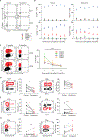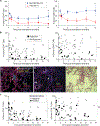Generation and persistence of human tissue-resident memory T cells in lung transplantation
- PMID: 30850393
- PMCID: PMC6435356
- DOI: 10.1126/sciimmunol.aav5581
Generation and persistence of human tissue-resident memory T cells in lung transplantation
Abstract
Tissue-resident memory T cells (TRM) maintain immunity in diverse sites as determined in mouse models, whereas their establishment and role in human tissues have been difficult to assess. Here, we investigated human lung TRM generation, maintenance, and function in airway samples obtained longitudinally from human leukocyte antigen (HLA)-disparate lung transplant recipients, where donor and recipient T cells could be localized and tracked over time. Donor T cells persist specifically in the lungs (and not blood) of transplant recipients and express high levels of TRM signature markers including CD69, CD103, and CD49a, whereas lung-infiltrating recipient T cells gradually acquire TRM phenotypes over months in vivo. Single-cell transcriptome profiling of airway T cells reveals that donor T cells comprise two TRM-like subsets with varying levels of expression of TRM-associated genes, whereas recipient T cells comprised non-TRM and similar TRM-like subpopulations, suggesting de novo TRM generation. Transplant recipients exhibiting higher frequencies of persisting donor TRM experienced fewer adverse clinical events such as primary graft dysfunction and acute cellular rejection compared with recipients with low donor TRM persistence, suggesting that monitoring TRM dynamics could be clinically informative. Together, our results provide spatial and temporal insights into how human TRM develop, function, persist, and affect tissue integrity within the complexities of lung transplantation.
Copyright © 2019 The Authors, some rights reserved; exclusive licensee American Association for the Advancement of Science. No claim to original U.S. Government Works.
Conflict of interest statement
Figures








References
-
- Mueller SN, Mackay LK, Tissue-resident memory T cells: local specialists in immune defence. Nat Rev Immunol 16, 79–89 (2016). - PubMed
Publication types
MeSH terms
Grants and funding
LinkOut - more resources
Full Text Sources
Medical
Molecular Biology Databases
Research Materials

